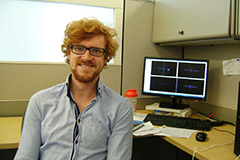Learning while teaching
By Betty Zou
How do you teach a computer new tricks?
That’s the question Jeremy Devine is trying to answer. Devine, a first year medical student at the University of Toronto, is trying to develop machine learning techniques that will automatically detect lesions on a brain scan. He is doing this work under the supervision of Dr. Anne Martel, a senior scientist in the Odette Cancer Research Program at Sunnybrook Research Institute (SRI).
“I’m trying to create [a computer program] that will automatically find those lesions in the brain without the help of an experienced radiologist,” says Devine, who is part of the D+H SRI Summer Student Research Program. “I’d like to think that if I do a good job, I kind of make the radiologist’s job obsolete in some ways.”
Helping him in his task is Dr. Arjun Sahgal, a scientist in the Odette Cancer Research Program at SRI and a radiation oncologist at Sunnybrook. Saghal has access to a large database of brain scan images from patients with brain metastases, cancers that have spread to the brain from another site in the body. Devine is using this dataset as a teaching tool to help his computer program learn to recognize what a brain lesion looks like.
“The more training data you have, the more accurate it’ll be,” he says. Right now his program can correctly identify lesions 85% of the time. However, it still reports a lot of false positives, regions that it thinks are lesions but are actually not.
Devine is currently fine-tuning his program to lower the false positive rate. “It’s tricky because if you lower the sensitivity, you might miss some lesions,” he says. “But if you raise the sensitivity, you might get too much junk.”
In addition to detecting brain lesions, he is also training his program to assess other features of a lesion like its area and perimeter. The size of a lesion is a commonly used metric to measure radiation response—did the lesion shrink, grow or stay the same after therapy? But as Devine notes, variation between radiologists who are interpreting these brain scans can make those differences hard to quantify.
“You can give the same scan to two radiologists and they’ll say, ‘The lesion is this big’ or ‘No, it’s actually this big,’” he says. “With a computer program, there’s less variation and it’s more objective.” He hopes that his program will help clinicians like Sahgal better understand how brain metastases respond to radiation therapy.
With only a few weeks left before the start of a new school year, Devine is driven to get as much done as he can. After a full day’s work, he often returns to the lab after dinner to check the results of his latest programming experiment and to set up a new experiment to run overnight. He admits that he can be a bit obsessive about his science projects. “They’re almost all consuming,” he says. “I think about them all the time.”
Despite the long hours and what he calls “the transient sense of hopelessness that comes with a failed experiment or a terrible result”, this experience has been a good one for Devine.
“One reason why I’m so happy in this lab right now is the freedom,” he says. “I don’t feel like there’s a hawk over my shoulder. I feel like I can make mistakes and learn my way.”
And when he’s learning, his computer is learning too.
Jeremy Devine received a D+H Summer Studentship Award.



